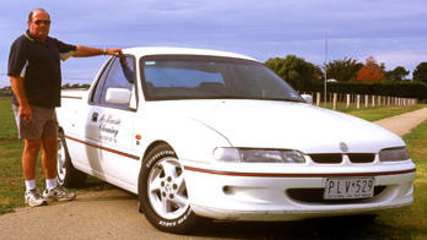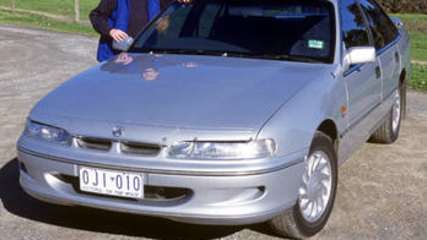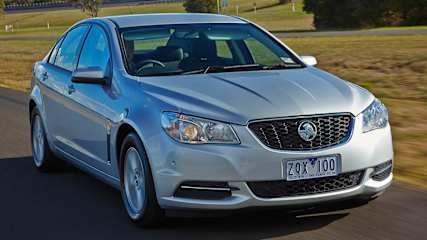Used Holden Commodore review: 1996-1997
By Graham Smith · 23 Jan 2009
If the popular theory holds true that the last model in the line is the best to buy then the VS model is the pick of the second generation Commodore. The theory is that by the time a carmaker releases the last model they’ve worked all the production wrinkles out of it, fixed the problems that have surfaced in service, and have developed it to its peak.According to the theory the last model of one generation is a better buy than the first of the next generation. Going by that it’s better to buy a VS Series II than it is to buy a VT Series.So if you value build quality and reliability above new cosmetics and gimmicks, it’s better to gamble on the older car.It’s also said to be true that it’s better to buy an optioned up model than a bare bones base car. Do that and you’ll find it easier to sell later on.For the used car buyer, the second owner, it’s often true that you can buy a better model without paying much more than you would if you were to buy a base car. It’s not only the value of the car that devalues, the add-on cost of buying an optioned up model also depreciates at the same time so the more expensive model can become more affordable as time passes.The Berlina, for instance, is the next model up the line from the Executive. The VS II Berlina cost $8230 more when new, but now costs little more than $2000 more than an Executive.While the extra equipment cost more when new, it doesn’t often cost much more when buying second hand. But what it can do is make the car more saleable as a second hand vehicle.MODEL WATCHThe final fling in the second generation Commodore line was the VS II released in 1996. It was designed to keep the old model fresh enough to keep attracting buyers until the all-new VT arrived in 1997.The second generation of the modern Commodore began with the VR model in 1993, and also took in the VR II update in 1994, and the VS, which hit the road in 1995.It was a much improved car compared to the previous generation of VN and VP models, which had Holden heading in the right direction after coming close to collapse in the late 1980s, but they were still being built to a tight budget.VR was a major breakthrough for Holden. It was much more refined, better built, and better equipped. Sales raced ahead and Holden was again in a position to threaten for the lead in the annual sales race.VS built on that success, and the VS II update simply added some more gloss to what was already a brilliant success story.The big news in the VS was the introduction of the smooth ECOTEC V6 engine. The same 3.8 litres in capacity, the new engine was an all new unit that was much smoother than its predecessor, produced more power (147 kW) and used less fuel (six per cent).For those who wanted more punch the 5.0-litre Holden V8 was optional. The all-Aussie V8 was coming to the end of the line, it was eventually replaced by the American Gen III 5.7-litre V8 in VT II.Although it dated back to 1968, the Holden V8 had been regularly updated over its long life span and was a much loved powerplant by those who appreciated its low down punch and pulling power. In VS II it put out 168 kW.A four-speed auto trans was standard, and the rear axle was a live unit.Buying a Berlina was about buying more creature comforts. Inside, the Berlina buyer got velour trim, automatic climate control air-conditioning, cruise control, power boot release, power mirrors, power steering, trip computer, sports seats, and a radio cassette sound system with six speakers.Remote central locking improved security, ABS improved the braking, and alloy wheels improved its looks.It was a model aimed at those who wanted more than was on offer in the Executive, but didn’t want to go all the way to the Calais which had all there was to offer in the Commodore family.IN THE SHOPHolden build quality improved dramatically with the VR and VS models. A new paint shop was commissioned in time for VR II production at the Elizabeth plant in South Australia, and that had a huge impact on paint quality.The ECOTEC V6 is generally quite reliable. Look for oil leaks around the timing cover, rocker covers, and oil pan. Make similar checks on the V8.Problem areas are the power steering pump, which leaks oil, and is known to fail, the electric fuel pump in the fuel tank, which is known to break down, and the power steering rack, which is known to leak oil.When checking the power steering rack, check the rubber boots carefully for damage, tears, splits, cracks etc. Damage to the boots allows road grime in and that can cause damage to the rack and its joints.Look carefully at the front and rear bumpers, and their mountings, for possible minor bingle damage. Look for misalignment where bumpers might have been poorly reattached after repairs.Many Berlinas were leased by company execs, who could afford more than a base model. They were usually turned over quite quickly, but often received minimal servicing, so check for a service record.IN A CRASHHolden became the first local carmaker to fit dual airbags to its car when it made driver’s and passenger’s airbags standard in the VS Acclaim and Calais. Sadly the Berlina had to make do with a standard driver’s airbag, the passenger’s airbag was an option.According to the recent used car survey of real life crashes, the VS Commodore performs pretty well. It has better than average crashworthiness, and is on a par with the fleet average in terms of its impact on the occupants of other cars.OWNERS SAYKim Maxwell loves the power of the V8 in her 1997 Berlina, but not the fuel consumption that goes with it. Maxwell and her husband, Garry, have owned the car from new and say it has been very reliable in the 180,000 km it has now done. The engine hasn’t “missed a beat”, Garry says, but a noisy diff required rebuilding at 125,000 km, the radiator, and worn suspension bushes have had to be replaced, and the silver paint has a few blotches.LOOK FOR• Value for money in extra options• Better resale potential than base model• comfortable family transport• reliable, smooth, economical V6• powerful but thirsty V8THE BOTTOM LINEWell equipped Berlina better value for money than Executive, but Acclaim makes more sense with ABS, IRS and airbags standard.RATING60/100









